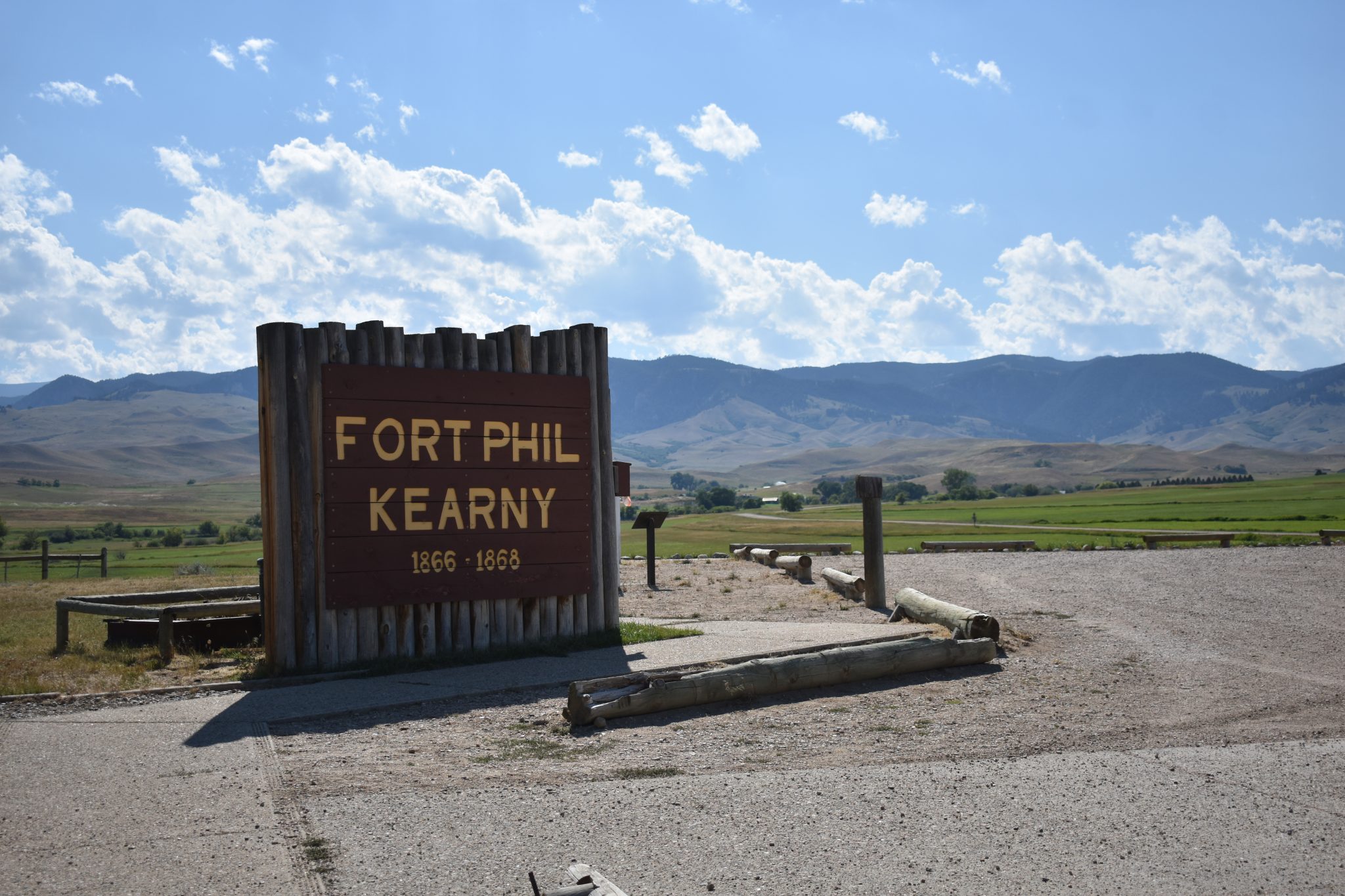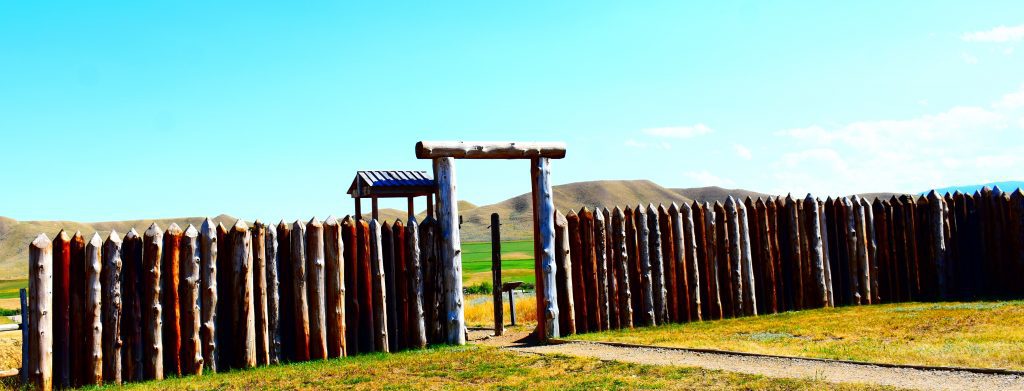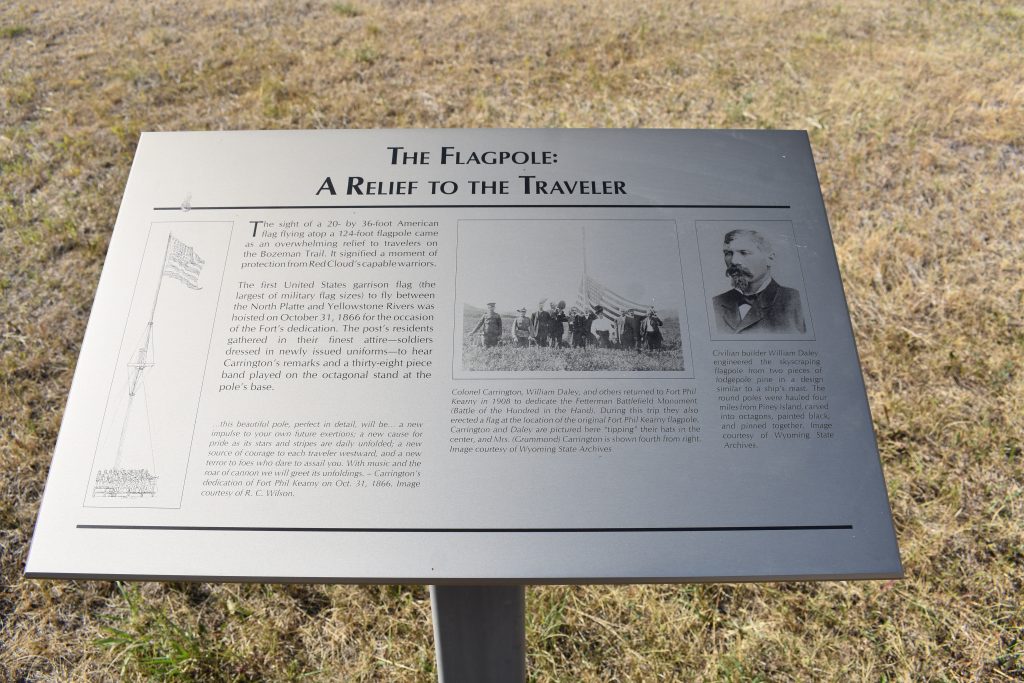News
Fort Phil Kearny
Published
2 years agoon
By
cvannoy
Fort Phil Kearny was an outpost of the U.S. Army along the Bozeman Trail near present day Story, Wyoming Construction began in the summer of 1866 under the direction of the regimental commander Colonel Henry B. Carrington. It was one of the forts that were constructed along the Bozeman Trail to protect the gold seekers through the hunting grounds of the Sioux tribe and their allies, who resented the encroachment of the white men.
The post was named for Major General Philip Kearny who fought in the Civil War. Today the fort is maintained by the State of Wyoming as the Fort Phil Kearny State Historic Site.
Kearny was the largest of the three stockaded forts along the Bozeman Trail. Carrington felt the stockade was necessary due to the hostile nature of the Sioux surrounding the fort. The eight-foot-high log walls enclosed an area of 17 acres. Construction continued into 1867 and consisted of native lumber and adobe bricks.

article: Thed was the reason for the forts along the Bozeman Trail. In a Wyoming Weekly Leader for Cheyenne, Wyoming, December 1869 there was this article: The Big Horn Country – As the Big Horn Mining Association appear to mean something, I deem it proper to contribute a little information on the subject, having scouted over nearly every part of that region while in the cavalry.
While at Fort Phil Kearney (sic) I made the acquaintance of a miner there, who in company with others, had discovered gold at three points in the range of the mountains, beginning about, or near, Crazy Woman’s Fork, and ending at a point about eight miles from Big Horn River, near Fort C. F. Smith, Montana Territory, he showed me both nuggets and dust of good quality. It was agreed between us that at the expiration of my enlistment we would let a few reliable men into our, or more properly his, secret (they each had some money and)…. we thought we could make nice a profitable beginning. The hostilities of the Indians precluded all action then, as it was after the horrible massacre of Col. Fetterman and his men; and then a came an order to evacuate the chain of Forts guarding that section, which of course ruined our project……Hoping that a good, well organized expedition may be completed, and prosper. I remain your obedient servant, Path Finder.

All forts had a flagpole, and it was a welcome sight to weary travelers, a promise of a safe place to rest along the trail. Fort Phil Kearny was no exception. In a The Sheridan Enterprise December of 1922, newspaper, there is this article: Rawlins, Wyo.— All of Wyoming pays tribute in the funeral services of the late William Daley of this city to one of the state’s foremost citizens, a man who has served well since coming to Wyoming as a pioneer with the military forces of the nation that aided in blazing the way for the coming of settlers….. William Daley was born June 13, 1844, at St. Johns, New Brunswick….His parents….. emigrated from Ireland to Canada. William Daley took up the trade of shipbuilding. In the spring of 1860, he was one of a party that left New Brunswick for the Rocky Mountain region. ….. where young Daley joined a firm which was taking supplies to Fort Phil Kearney, then building on the Bozeman Tail. When Fort Phil Kearney was reached in 1866, after an adventurous trip, Daley signed up with the government. It is doubtful if ever a post on the western frontiers was continually harassed during the period of construction as was that of Fort Phil Kearney. With the completion of the structure, flag-raising day came on October 31. The flagpole stood one, hundred twenty-four feet high and was largely the product, of William Daley’s mechanical skill. The flag at the top that day was the first full “garrison flag” that ever floated between the Platte and Montana, and Mr. Daley had the honor of hoisting it for the first time.
At its peak, the garrison boasted of 400 soldiers, four to six infantry companies and one or two companies of cavalry. There were around 150 civilians in the fort, as well as nine officers, and a surgeon. Hostile incidents were almost a daily occurrence.

In The Sheridan Post, December, 1903 an old soldier tells his version of the Bingham Fight in December 1866 that preceded the Fetterman Massacre a few days later. Mr John T. Guthrie, inmate of the United States soldier home at Washington, DC….. and for several years a subscriber of The Weekly Laramie Republican, sent that paper a clipping from the Washington Times of Sunday, December 6 and the following note…. In this last visit I gave to Colonel Winfield Edgerly, of the Second Cavalry, a picture of the fight on what is now called Pony creek. In this fight with the Indians, Lieutenant Bingham of Troop C, to which I belonged, was killed December 6, 1866, outside the walls of Fort Kearney, in the valley of the Pine Ridge, in the Big Horn mountains and the picture showed the fight and the death of our brave lieutenant the hands of Sioux savages. The picture affords a full and satisfactory answer to inquiry about the lost history of that battle and lifts a curtain which has shrouded the history of the Second Cavalry in that campaign…….Old John Guthrie, of the Second Cavalry, is the sole survivor of an ambush in which Lieutenant Bingham, of Company C, Second, was killed, and which occurred on December 6, on what was then called Cedar Creek.
Guthrie is an old man now, but his blue eyes still retain much of the keenness and fire that enabled him to make a reputation for himself as Indian scout in the Northwest many years ago. Every year on Dec. 6th, he puts in extra work on the history he is writing of the stirring events in which he has taken part, because it is the anniversary of the day upon which his favorite officer was murdered by the Sioux.
A few days ago he completed a watercolor painting of the fight in which Bingham was killed, an account of the affair as he saw it. ”At that, time the Second Cavalry was shut up in Fort Phil Kearney, for the Big Horn country was alive with Sioux, and it was unsafe for so small a body of soldiers to stir far from shelter. About midday, on December 6. a band of Indians ran down a small herd of cattle that belonged to the fort, and with lances and sleigh bells, they stampeded the whole herd.
Lieutenant Bingham and twelve troopers set out in pursuit of the Indians and the cattle and ran them into a thick clump of willows on Cedar creek, now called Pony creek, about twelve miles from the fort. As soon as the soldiers entered the thicket, they found it alive with Indians. Realizing they had been ambushed, they began at once to fight their way out Lieutenant Bingham was shot down. Seeing they could not save him, the twelve troopers, every one of whom was wounded, got back to the fort as quickly as their horses could carry them. There is none in the Second Cavalry now but John Guthrie of Company C. who took part in this fight, so he alone is left, to commemorate the anniversary of Lieutenant Bingham’s murder at Cedar Creek.
In 1868, Fort Phil Kearny, Fort Reno and Fort C.F. Smith in Montana, were abandoned. The 1868 Treaty of Fort Laramie recognized the Powder River Country as unceded hunting territory for the Lakota and their allies. As a part of the treaty, the U.S. government shut down travel by settlers along the Bozeman Trail. President Grant ordered the abandonment of forts along the trail. Later, Fort Phil Kearny was burned to the ground by a band of Cheyenne warriors.

However, the fort and the battles were not forgotten. In the Semi-Weekly Enterprise Sheridan, June 16, 1908. Sioux Warrior May Come Red Cloud Invited to Participate in Carrington Reunion and Fourth of July Celebration in Sheridan. Interest in the coming Carrington reunion and Fourth of July celebration in Sheridan is heightened by the announcement today that Red Cloud, the old Sioux warrior, who led the hostile savages against the United States troops in Wyoming 42 years ago, and who occupied relatively the same position for the reds as did General H. B. Carrington, then a colonel in the regular army, for the government forces, will probably come here and participate with his former foe in the festivities of a great occasion.
Members of the committed appointed by the Sheridan-chamber of commerce to arrange for the reunion and oration learned a couple of days ago that Red Cloud, who is now fully 90 years of age, but still enjoying good health, was at Pine Ridge agency, South Dakota, where the remnant of the once powerful Sioux tribe is located.
On June 19, this ad appeared, Chief Red Cloud who led the Indian Horde in 1866, will be present and with General Carrington and will witness the thrilling Reproduction of the Fetterman Massacre by the United States Regulars and Crow Indians.
On July 3rd in the same paper this update appeared, While the Indian warrior is past 90 years and is totally blind, it was at first thought he could make the trip from Pine Ridge Agency, S. D., where he has lived for many years, but it was finally decided that he was too old and feeble to stand the long ride.
In the Semi-Weekly Enterprise Sheridan, in June 30 of 1908: Carrington Reunion and Fourth of July Celebration Combine to Make Occasion One of Magnitude General H. B. Carrington. accompanied by his wife, is in route from his home in Hyde Park, Boston, to the great reunion celebration of the survivors of the Fort Phil Kearney massacre at Sheridan, July 3 and 4. He wrote to the chamber of commerce committee, arranging for the affair, that he would arrive here Tuesday, June 30, but a special from Omaha States he will reach that city today (Monday) and remain there until Tuesday afternoon, bringing him to this city 26 hours later. From Omaha to Sheridan General Carrington will be accompanied by Sergeant Gibson and S. S. Peters, both with him survivors of the massacre, who will be hia personal aides at the local celebration. There are three other survivors of the massacre living in Omaha, Maurice Barnes, Pat Desmond and Henry Ferster, who may accompany the old general here.

In the Encampment Record, January 1916, it says this: Monument at Fort Phil Kearney, Sheridan, A bill appropriating $3,000 for the purpose of erecting monuments on the site of Fort Phil Kearney, on Piney Creek, and on the site of the Wagon Box Fight, a few miles above on the same stream, has been introduced in Congress by Congressman Mondell.
Today, the old fort has been given new life. It is a Wyoming State Historic Site and was named a National Historic Landmark in 1960. There is an interpretive center to introduce visitors to the fort and its place in Western History. There is a diorama depicting, to scale, the fort as it would have looked in 1866. Signs have been set up to inform visitors where original buildings stood, and stockade sections demonstrate exactly how the walls were built to protect the garrison and civilians against the hostile Indians and the harsh Wyoming elements. Visitors can see the reconstructed stockade walls, and the expansive grounds of the largest stockaded fort along the Bloody Bozeman.


Laura Neva
January 3, 2022 at 11:35 pm
Very nice historic reminder, thank you
Loren Hoffman
March 8, 2022 at 12:33 pm
Maurice Barnes was my great grand uncle. He and his dad, John Haddock Barnes
enlisted in Cincinnati in 1861. They were F&S 18th Infantry and were
part of the Chattanooga and Chickamauga campaigns. His dad was the Drum Major
and Maurice was a Drummer Boy. Maurice was 10 years old at his first enlistment.
After the Civil War, they re-enlisted and did were posted at Fort McPherson
and Fort Phil Kearney. They were always posted together. His dad was one of those
who erected the Fort Phil Kearney’s flagstaff. Maurice was discharged in April, 1868.
He briefly joined a traveling circus before settling in Omaha, Nebraska in 1876.
He married Mary Walker, they had two daughters. He had a very successful career
working as a salesman for the National Biscuit company and was a beloved musician at
the Boyd Theater. He died too soon, at age 74, in Omaha, Nebraska.